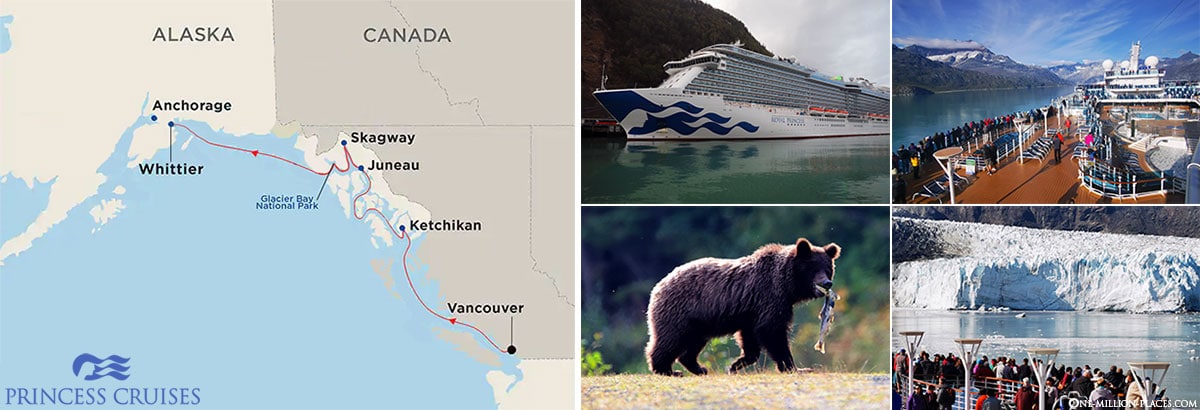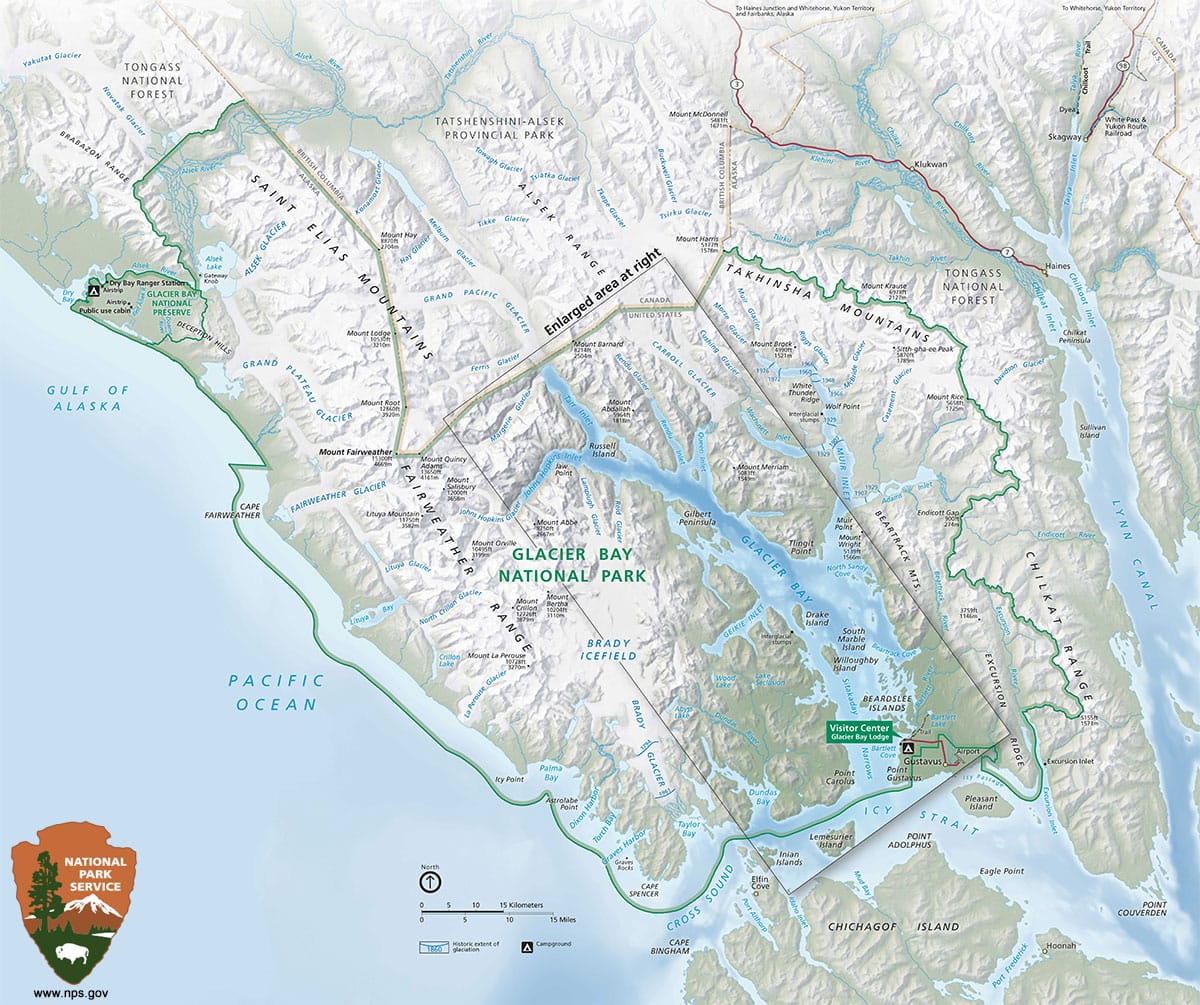After the last days on our journey through the Inside Passage the cities of Ketchikan, Juneau, Skagway and Haines, the last 2 days of our Alaska cruise with Princess Cruises were a “Scenic Cruise”. This means that the ship no longer docks in a harbour, but that you can admire the highlights of Glacier Bay National Park and college fjord directly from the ship.
Table of contents
Glacier Bay National Park in Alaska
Glacier Bay National Park is one of alaska’s highlights and is a UNESCO-based world heritage site. The region has the largest non-polar ice field in the world!
Things to know about the park
Glacier Bay National Park attracts up to 400,000 visitors a year and is located in southern Alaska, about 150 kilometers northwest of the capital Juneau. The park offers snow-covered mountain ranges that reach up to 4,500 meters in height. The highest point is on the flank of Mount Fairweather, which is 4,663 metres high.
The national park, which covers more than 13,000 km2, has been a protected area since 1925. When the English captain George Vancouver first explored the present region in 1794, the bay was almost completely covered by the ice of the glaciers. But as early as 1879, less than 100 years later, the Scottish scientist John Muir discovered that the ice masses had receded by up to 80 kilometres. Many parts of the Bay were now ice-free. The warming of the earth – and the associated decline of glaciers – can be seen impressively in the park to this day.
Arrival
There are no roads leading to Glacier Bay National Park! If you want to visit the park individually, you have to travel either by plane or by boat.
By cruise ship: The vast majority of visitors (98) explore the park on board a cruise ship and do not land on land. It is interesting that a total of only 7 shipping companies have permission to sail to Glacier Bay. In October 2019, new 10-year concession contracts were awarded to the following shipping companies: Princess Cruise Lines, Holland America Line, NCL, Carnival, Seabourn Cruise Line, Viking Cruises and Royal Caribbean.
By plane: The small airport is located in Gustavus, the so-called “Gateway to Glacier Bay National Park”. From here, flights to Juneau, Haines and Skagway depart during the summer months.
By ferry: Since 2011, the Alaska Marine Highway ferry system has provided regular service from Juneau to Gustavus. The only notable road is 15 kilometres long and leads from the airport via the village of Gustavus directly to the visitor centre.
Accommodation
Directly in the National Park there is a campsite and only one accommodation: Glacier Bay Lodge in Bartlett Cove. Prices for a double room usually start at 200 EUR per night. Outside the park, there are also a few simple accommodations and bed and breakfast guesthouses in the small town & Gustavus.
The Visitor Centre
If you want to find out more about the park, the best way to do this is at the Glacier Bay National Park Visitor Center on the first floor of Glacier Bay Lodge. The Info-Center is open from the end of May until the beginning of September. Many hiking trails are accessible from the visitor centre. Kayak and boat rentals are also available.
The best way to get to know the park is a Glacier Bay Day Tourled by park rangers, which starts at 7.30in from glacier Bay Lodge’s dock. During the tour, a high-speed catamaran travels between islands that were completely covered by ice 200 years ago and visitors to the massive tidal glaciers, some of which rise more than 75 metres out of the water, at close range. The price for the all-day day tour, which includes lunch and drinks, is currently USD 220 + tax per person.
Admission & Opening Hours
The park is open all year round, but only limited services are available during the winter months. There is no entrance fee for Glacier Bay National Park and Preserve.
The wildlife in the park
The densely wooded islands of the national park are home to numerous animal species, such as brown bears, black bears, wolves, snow goats, moose, coyotes, foxes, marmots, porcupines, red squirrels, bald eagles and more than 200 other bird species. The water is home to a variety of marine mammals such as killer whales (orcas), humpback whales, grey whales, seals, seals, sea otters, beavers and, of course, a lot of salmon.
The glaciers in the park
Today, about 27 percent of Glacier Bay National Park is still covered by glaciers. Of the 100 glaciers that traverse the national park in four mountain ranges, 7 extend to the tidal-influenced waters of the fjords. The ice, which often breaks off loudly from the front of the glaciers, is on average 200 years old. One of the most spectacular glaciers is clearly the huge Margerie Glacier in the Tarr Inlet. After 34 kilometres of length, it flows directly into the sea in a steep wall that is more than 75 metres high.
We also found this map very impressive, showing the different glacier expansions over the course of the year. Thus you can see that in 1794 the entire Glacier Bay was still covered with ice.
The Scenic Cruise through Glacier Bay National Park
Our trip to the National Park aboard the Royal Princess began in the early morning when a park ranger arrived at Bartlett Cove at 6.15am. The rangers tell a lot about the history of the national park, the local wildlife and the unique nature during the ride via the ship’s loudspeakers.
Die Glacier Bay
The first 3 hours of the Scenic Cruise led through the mirror-smooth Glacier Bay,past deserted islands such as Strawberry Island, Willoughby Island or Drake Island, 3,000 meters high snow-capped mountains and majestic glaciers – and this in a dream weather ☼
Lamplugh Glacier
The first highlight of the cruise through the Nationlpark is the Lamplugh Glacier. This glacier, which is 16 kilometres long and up to 1.5 kilometres wide, flows north-northwest from Brady Icefield to the Johns Hopkins Inlet. The ice front at the lower end of the glacier has a width of 1.2 kilometres and rises up to 45 metres above the water. In the meantime, the ice of the glacier has already receded so far that it unfortunately no longer reaches the water.
The Johns Hopkins Inlet
From Lamplugh Glacier, the Royal Princess then drove to Johns Hopkins Inlet, a bay at the mouth of Johns Hopkins Glacier. The backdrop of the narrow fjord with its steeply towering mountains and snow-covered peaks was truly magnificent 🙂
The Margerie Glacier in Tarr Inlet
From Johns Hopkins Inlet, the journey continued into Tarr Inlet, the northernmost side arm of Glacier Bay. The Inlet is about 15 kilometers long and three kilometers wide and runs almost to the border with Canada. The Grand Pacific Glacier, which has no continuous ice surface up to the water, flows into the head area of the bay, the Margerie Glacier is located a little further south on the left bank.
The Margerie Glacier is a 34 km long glacier and certainly the highlight of the Scenic Cruise in Glacier Bay National Park. The glacier rises on the southern flank of Mount Root and flows from there to the Tarr Inlet. The ice front rises about 75 meters above the water of the fjord and another 30 meters lie below the waterline. The Margerie Glacier is one of the few glaciers that still grow today: the ice front grows by around ten metres every year!
In total we drove 9 hours through the Glacier-Bay National Park and were also very lucky with the weather: an almost bright blue sky and pleasant temperatures. This can be quite different here in the area. Overall, we liked the Scenic Cruise very much and reminded us a little of our cruise through the Geirangerfjord in Norway 😉
Around 3 p.m. the Park Ranger left our ship and we continued our journey north towards Anchorage.
All travelogues from our Alaska Cruise
Our cruise on the Royal Princess took us for a week along the coast from Vancouver north to Whittier (Anchorage). On this great cruise adventure around the northernmost state of the USA we visited the cities of Ketchikan, Juneau and Skagway. We also took a scenic cruise in Glacier Bay National Park and College Fjord with breathtaking views of Alaska's glaciers.
Day 1: Visa – Entry to Canada (eTA Application) & to the USA (ESTA Application)
Day 1: Vancouver – Tourist Attractions, Things to Do & Photo spots (Canada)
Day 1: Royal Princess – Our ship for the Alaska Cruise
Day 2: Day at Sea
Day 3: Ketchikan – Totemp poles, bald eagles & salmon (USA)
Day 4: Juneau – Things to do in the capital of Alaska (USA)
Day 4: Juneau – Orcas and humpback whales at Whale Watching (USA)
Day 4: Juneau – A trip to mendenhall Glacier (USA)
Day 5: Skagway – A walk through the old gold mining town (USA)
Day 5: Skagway – Musher’s Camp & Dog Sled Adventure (USA)
Day 5: Haines – Bears and bald eagles on the Chilkoot River (USA)
Day 6: Glacier Bay National Park – A Scenic Cruise in Alaska (USA)
Day 7: College Fjord – A Scenic Cruise & Arrival in Whittier (USA)
Day 8: Anchorage – Seward Highway & Alaska Wildlife Center (USA)



